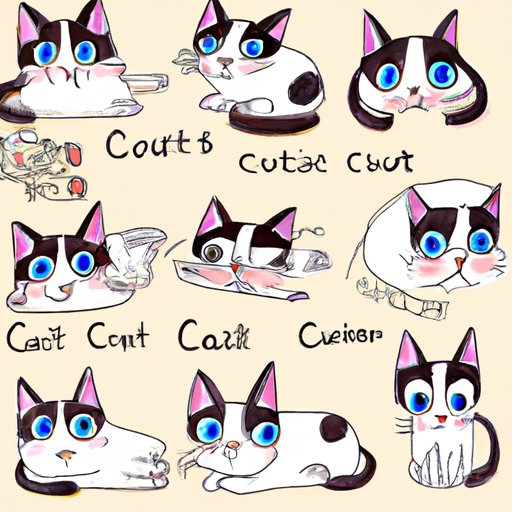
Introduction
Are you a fan of cartoons and want to learn how to draw a cartoon cat? Whether you’re an aspiring artist or just looking to expand your skills, drawing a cartoon cat is a fun and rewarding challenge. This step-by-step guide will walk you through the process of creating your own cartoon cat while providing tips and tricks to make your drawing stand out. From sketching out the basic shapes to adding shading and texture, this guide will teach you everything you need to know.
Step-by-step tutorial
Before you begin, it’s important to remember that drawing a cartoon cat is all about breaking down the process into simple steps. By following this step-by-step tutorial, you’ll be able to create a cartoon cat that looks professional and polished. Here’s what you’ll need to do:
Sketching the basic shapes of the cat’s body and head
Start by sketching out the basic shape of the cat’s body using a light pencil. Draw a large circle for the head and a smaller circle for the body, connected with a curved line. Add two smaller circles for the cat’s paws and a longer oval for the tail. Keep the lines loose and light as you’ll be refining them later.
Adding details to the face, like the eyes, nose, and mouth
Using the base circle as a guide, draw the cat’s face with a smaller circle for the snout and two triangle-shaped ears. Add eyes, a nose, and a mouth to the cat’s face to give it personality. Make the eyes large and expressive, and give the cat a cute little nose and mouth.
Drawing the cat’s ears, paws, and tail
Once the basic shape is in place, start adding details to the cat’s body. Draw in the ears, ensuring they are the right size and shape for your cat. Add the paws by drawing circles at the bottom of each leg. Finally, draw the cat’s fluffy tail by sketching out a curved line with fluffy edges. Remember that cats are very flexible and can curl up into all sorts of shapes!
Adding texture and shading to give the cat dimension
Now it’s time to add some depth to your drawing. Using a slightly darker pencil or a pen, begin to add lines and texture to the cat’s body. Make the fur look fluffy by drawing individual hairs in the direction that they would naturally lay. Shade in the curves and creases to give the cat dimension and shape. Add shadows to the eyes and nose to make them look realistic.
Observing real cats
If you want to create a truly accurate and lifelike cartoon cat, it’s important to study real cats and understand their anatomy and movements. By observing real cats, you’ll be able to make your cartoon cat look more realistic and expressive. Here are some tips to help you observe cats more effectively:
– Pay attention to the way they sit, stand, and move
– Watch how they interact with their environment and other animals
– Take note of their facial expressions and body language
– Observe the small details like the shape of their ears, the tilt of their head, and the curve of their tail
Tips and Tricks for drawing cartoon cats
Creating a cartoon cat is all about adding unique and interesting details that make your cat stand out from the rest. Here are some tips and tricks to get you started:
– Choose colors that fit the cat’s personality, like bright and bold or dark and mysterious
– Use shading and texture to make the cat look fluffy and soft
– Add unique features like different-colored eyes, unique patterns, or cute accessories like a bow or hat
– Experiment with different styles like realistic, anime-inspired, or cartoonish
– Practice drawing from different angles and perspectives to make your cat look more dynamic
History of cartoon cats
Cartoon cats have a long history in popular culture, and different artists have interpreted them in unique ways over the years. Some of the most famous cartoon cats include Garfield, Tom from Tom and Jerry, and the Cheshire Cat from Alice in Wonderland. Here are some of the unique characteristics of these famous cats:
– Garfield: A chubby, lasagna-loving cat with a sassy attitude and sarcastic wit
– Tom: The scheming, mischievous feline from the classic cartoon Tom and Jerry
– Cheshire Cat: The grinning feline from Lewis Carroll’s Alice in Wonderland known for its mysterious and unpredictable nature
Creating cats with personality
The most memorable cartoon cats are the ones with distinct personalities that stand out from the crowd. To give your cartoon cat personality, try to convey emotions and feelings through body language, facial expressions, and other details. Here are some examples of different types of personalities and how they can be conveyed in a cartoon cat:
– Playful: Make the cat look relaxed and happy, with a tail held high and a playful expression on its face
– Shy: Draw the cat with its ears down, tail tucked in, and eyes looking away
– Curious: Make the cat look alert and attentive, with the head held high and the ears perked up
Conclusion
Drawing a cartoon cat is a fun and rewarding challenge that anyone can enjoy. By following this step-by-step tutorial and practicing your skills, you’ll be able to create your own unique cartoon cats with personality and style. Keep experimenting with different techniques and styles, and don’t be afraid to try new things.





